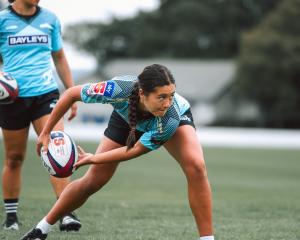ODT Online rugby writer Jeff Cheshire identifies some key points from the Highlanders' win over the Cheetahs in South Africa at the weekend.
Making use of space
Rugby is a game of space. You want to exploit the space the opposition gives you and if you want it in different areas, you have to manipulate it. The Highlanders did this extremely well, spreading the ball wide and kicking in behind the Cheetahs' defensive line. The Cheetahs employed a narrow, flat defence, which saw them try to stifle the Highlanders midfield and get up quick to prevent them getting it wider.
In general, the first part of this worked. The Highlanders were well-contained through the midfield. But their high skill level and quick hands allowed them to get the ball wide, where there was plenty of space, while Lima Sopoaga and Ben Smith kicked well and good chases ensued, to ensure the space behind the defensive line was exploited too. It forced the Cheetahs to scramble in cover defence, which they did not do well and the Highlanders speed, skill and support play was too much for them to handle.
When a player gets a good reputation...
When a player gets a reputation as a wrecking-machine with ball in hand, opponents take notice and can base their defences around them. This seems to be what the South African teams have been doing with Malakai Fekitoa, particularly the Sharks and Cheetahs. In a similar way to what they did a decade ago with Jonah Lomu, they are committing multiple players to him in order to stop his strong running before it starts. It seems to be working too, he has not made the multiple breaks against those teams as he has against others. But the flow-on effect is that it opens up space elsewhere and they are not doing a good job of shutting this down.
When you have so many attacking threats in a team, it is inevitable that focusing on one or two players is going to make it tough, as it did for the Cheetahs. Not every team takes this approach, but to have a player on your team who is capable of impacting a game simply by being on the field, well that has to be a good thing.
Tight five outstanding all-round game
As brilliant as the backs and were in the first half, the tight five were just as good, if not better. In such an open game played with speed and width, sometimes the significance of what the tight five is doing can fly under the radar. You do not see them making tackles, or strong runs, or making big hits. What was more impressive was their speed and effectiveness at the breakdown, as well as their dominance of the set-piece. This was particularly the case when you consider the loose-forwards were playing more of a ranging role, which meant the tight five had to be good. If they were not, holding onto the ball would have been so much tougher. All five men in this area worked hard and never stopped. Their set-piece was outstanding too. The scrum was strong and the lineout was accurate, particularly considering a lot of ball was thrown to the back, which enabled the backs to use the ball in more space.
Cheetahs comeback around time of changes
The Highlanders made a series of changes in their forwards in the middle of the second half, which coincided with the period where the Cheetahs had their good patch. Of course it hard to blame this solely on the newly introduced players, but there was a definite drop off in the impact of the tight five. The scrum became a mess, for both teams, and the Cheetahs seemed to get much quicker ball and find a lot more space. Then they came right. After the third try there was a real resolve evident to prevent a fourth being scored. It was clear that this combination of players was capable. But it did show that it took them ten minutes or so to really have an impact on the game as a collective. That is not uncommon; most starting players generally take a while to feel their way into the game too.
When you are rotating your line up from week to week it is inevitable that these men are not going to be superstars when it comes to coming on and getting straight into it. So what is the answer? Perhaps not making so many changes in one area in such a short space of time would help. Obviously it is a balancing act, as fatigue has to be factored in. But bringing four new players into the tight five in the space of 15 minutes is likely going to spark some sort of change in the way they are playing, particularly as they all take a few minutes to get a feel for the game. Of course most teams use similar tactics. However, different teams react differently to these changes and it has been a trend that the Highlanders have been forced to hold on, rather than be on top, after these changes.
Squad depth
The issues after making changes do not mean that the team lacks for quality though. There is hardly any player in the squad that you would be worried about slotting into the starting line up, which is a huge plus when it comes to team selection. In this game the Highlanders were without their leading try scorer in Waisake Naholo, but retained an abundance of firepower. In other weeks, there have been different players step into different roles. It is evident in the forwards in particular, where other than Nasi Manu, there is hardly a player that really stands out as being more important than the others. They are all capable of doing similar things to similarly high levels. Alex Ainley came in on debut and was outstanding, although heading into the game he would have ranked fourth in the pecking order for locks. There are three outstanding blindside flankers on show, along with two top quality hookers and four good props. On the openside the first choice player, Shane Christie, has not even been sighted, yet they have functioned fine without him. To be able to pick and choose from a squad with this sort of depth has make life so much easier for the coaching staff.
When to rest the All Blacks?
Of course the three players who you really would not want to lose are the three current All Blacks: Ben Smith, Aaron Smith and Fekitoa. Indeed the one game where they were rested was the team's worst of the year, although whether it was this that made the difference is debatable. That said, there is no denying all three do make a difference to this Highlanders outfit.
So the question must be asked, in which game could they do without them? Next week's clash with the Force is match that they need to be targeting, so they need to play that one. Then there is the match-up with the Blues in the final round, another one which should be targeted. This leaves the Chiefs and Hurricanes. Both are tough challenges, but in terms of the overall table, the Chiefs one is more important. Given the two teams are neck and neck as far as points goes, being able to gain four points, while also taking between two and four off the other is going to be huge. In contrast, the Hurricanes are looking almost certain to finish top now, meaning beating them is not going to have the same double-impact. From this perspective, the Hurricanes game might be the best option to give the All Blacks a break.
Impressive win in South Africa
Do not underestimate this win, even if it was against the lowly Cheetahs. To play so well in South Africa and at high altitude is a tough thing to do, particularly after last week's nightmare second half.
They came out looking energised and confident and while they wilted a bit at the end, it was a classy performance which sees them return from South Africa with five competition points.











